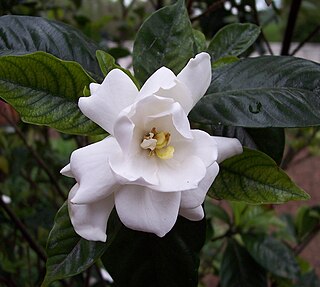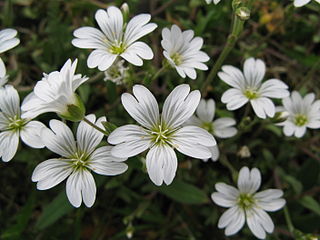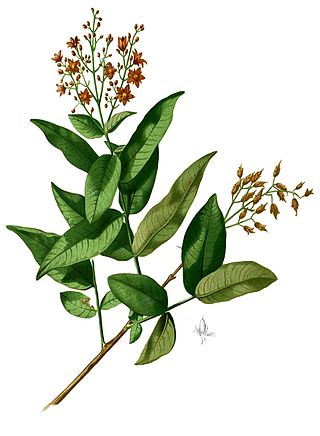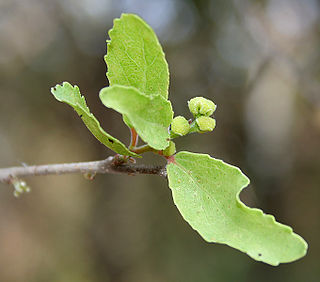
Scaevola is a genus of flowering plants in the Goodenia family, Goodeniaceae. It consists of more than 130 species, with the center of diversity being Australia and Polynesia. There are around 80 species in Australia, occurring throughout the continent, in a variety of habitats. Diversity is highest in the South West, where around 40 species are endemic.

Gardenia is a genus of flowering plants in the coffee family, Rubiaceae, native to the tropical and subtropical regions of Africa, Asia, Madagascar, Pacific Islands, and Australia.

Ocimum is a genus of aromatic annual and perennial herbs and shrubs in the family Lamiaceae, native to the tropical and warm temperate regions of all 6 inhabited continents, with the greatest number of species in Africa. It is the genus of basil and its best known species are the cooking herb great basil, O. basilicum, and the medicinal herb tulsi, O. tenuiflorum.

Cerastium is a genus of annual, winter annual, or perennial flowering plants belonging to the family Caryophyllaceae. They are commonly called mouse-ears or mouse-ear chickweeds. There are 214 accepted species, found nearly worldwide but with the greatest concentration in the northern temperate regions. A number of the species are common weeds in fields and on disturbed ground.

Cratoxylum is a genus of flowering plants in the family Hypericaceae, native to tropical Asia. The generic name means "strong wood", referring to the timber.

Plectranthus is a genus of about 85 species of flowering plants from the sage family, Lamiaceae, found mostly in southern and tropical Africa and Madagascar. Common names include spur-flower. Plectranthus species are herbaceous perennial plants, rarely annuals or soft-wooded shrubs, sometimes succulent; sometimes with a tuberous base.

Banara is a genus of flowering plants in the family Salicaceae.

Helicia is a genus of 110 species of trees and shrubs, constituting part of the plant family Proteaceae. They grow naturally in rainforests throughout tropical South and Southeast Asia, including India, Sri Lanka, Indochina, Peninsular Malaysia to New Guinea and as far south as New South Wales.
Heliciopsis is a genus of about fourteen species of trees, constituting part of the flowering plant family Proteaceae. They grow naturally in Myanmar, Indo-China, China, Thailand, Peninsular Malaysia, Borneo, Sumatra, Java (Indonesia) and the Philippines. The name means similar to the plant genus Helicia. Its closest relatives are Athertonia (Australia) and Virotia.
Homalium dalzielii is a species of plant in the family Salicaceae. It is found in Benin, Nigeria, and Cameroon. It can grow up to 40 feet high.

Olax is a plant genus in the family Olacaceae. The name derives from the Latin, olax (malodorous), and refers to the unpleasant scent of some of the Olax species. Olax is an Old World genus represented by several climbers, some species have leaves and fruits smelling of garlic such as Olax subscorpioidea and Olax gambecola, seeds of the latter are used as condiments in parts of West Africa. In India Olax nana is well known as one of the first species to emerge after forest fires, the shoots growing directly from buried roots.

Flacourtia is a genus of flowering plants in the family Salicaceae. It was previously placed in the now defunct family Flacourtiaceae. The generic name honors Étienne de Flacourt (1607–1660), a governor of Madagascar. It contains 23 species of shrubs and small trees that are native to the African and Asian tropics and subtropics. Several species, especially Flacourtia indica, are cultivated as ornamentals and for their fruits. The trunks of small trees are often guarded by branching spines.

Platostoma is a genus of flowering plants in the mint family, Lamiaceae, first described as a genus in 1818. It is native to tropical parts of Africa, southern Asia, Papuasia, and Australia. Mesona and Acrocephalus has been known as its synonyms.

Calantica is a genus of flowering plants in the family Salicaceae. It contains 10 species of shrubs and trees endemic to Madagascar, seven of which are threatened. Calantica is closely related to the pantropical and diverse genus Homalium, from which it differs in having a superior ovary, instead of a semi-inferior ovary. The genus is also similar to Bivinia in its superior ovary but has numerous stamens and long spiciform inflorescences.
François Pellegrin was a French botanist, who specialised in the plants of tropical Africa.
Adenosma is a genus of flowering plants belonging to the family Plantaginaceae.
Cyanocephalus is a genus of flowering plants belonging to the family Lamiaceae.
Pellegrinia is a genus of flowering plants belonging to the family Ericaceae.

Rhaphiostylis is a genus of flowering plants belonging to the family Metteniusaceae.














